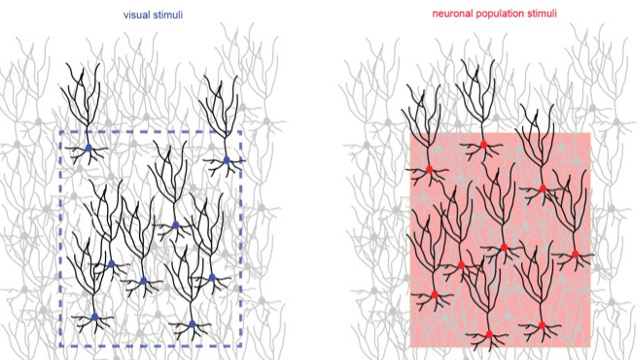Sets of neurons in the brain that behave together—firing synchronously in response to sensory or motor stimuli—are thought to be functionally and physiologically connected. These naturally occurring ensembles of neurons are one of the ways memories may be programmed in the brain. Now, in a paper published today (August 11) in Science, researchers at Columbia University and their colleagues show that it is possible to stimulate visual cortex neurons in living, awake mice and induce a new ensemble of neurons that behave as a group and maintain their concerted firing for several days.
“This work takes the concept of correlated [neuronal] firing patterns in a new and important causal direction,” David Kleinfeld, a neurophysicist at the University of California, San Diego, who was not involved in the work told The Scientist. “In a sense, [the researchers] created a memory for a visual feature that does not exist in the physical world as a proof of principal of how real visual memories are formed.”
“Researchers have previously related optogenetic stimulation to behavior [in animals], but this study breaks new ground by investigating the dynamics of neural activity in relation to the ensemble to which these neurons belong,” said Sebastian Seung, a computational neuroscientist at the Princeton Neuroscience Institute in New Jersey who also was not involved in the study.
Columbia’s Rafael Yuste and colleagues stimulated randomly selected sets of individual neurons in the visual cortices of living mice using two-photon stimulation while the animals ran on a treadmill. The researchers could distinguish between those neurons that were directly stimulated by light from the group of neurons that were indirectly activated. Upon repeated light stimulation, the researchers observed the same group of photoactivated neurons firing. This artificially induced group of neurons was different from other ensembles of cells that fired as a result of control, nonoptogenetic visual stimuli, the researchers reported.
“This is an exciting discovery for us, that activity can be written into the cortex,” Yuste said. “We don’t really know how networks of neurons are connected so it was not obvious that this experiment would work.”
The researchers “used their experimental system to demonstrate [that with] pattern completion, the idea that once the cortex learns the imposed pattern, presumably through synaptic connectivity, [they] can excite only a few of the cells and the entire pattern is reformed,” explained Kleinfeld. “This feature is a hallmark of associative memories formed from heavily interconnected groups of neurons.”
According to study coauthor Luis Carrillo-Reid, a postdoctoral fellow in Yuste’s lab, the idea behind the study was born out of a control experiment to make sure that the team’s two-photon stimulation technique could reliably stimulate the same few neurons. “We consistently saw that when we stimulated the same area of the cortex several times, the same group of neurons were simultaneously activated. This led us to ask whether we were creating a new circuit in the brain,” Carillo-Reid told The Scientist.
After the team repeatedly stimulated groups of neurons associated with the newly created co-firing ensemble, additional single-cell stimulation resulted in firing of that same ensemble 64.5 percent of the time over two consecutive days.
Other researchers, including György Buzsáki at New York University’s Langone Medical Center, have previously attempted to artificially induce such plasticity into the brain.
Stimulating the hippocampus electrically, Buzsáki was able to show spontaneously occurring neuronal population patterns, similar to the ensembles in the current study. “The new findings are superior in many aspects because the authors were able to monitor individual neurons over days, as opposed to my crude population average measures,” Buzsáki, who was not involved in the current study, wrote in an email toThe Scientist.
In comparing the light-stimulated groups of neurons with naturally activated brain cells within the visual cortex, the team found that both contained similar numbers (between 10 and 20 cells) and showed similar distributions throughout the brain. But the average distance between neurons within the artificially stimulated ensemble was shorter.
Because light stimulation of only about 8 percent of neurons within an ensemble initiated firing of the entire group of cells, an open question is what makes these cells unique. Do these cells show robust connectivity, and are they “stronger, say, when it comes to recall?” Buzsáki wrote.
For Kleinfeld, another open question is whether the observed concerted neuronal activation means that synapses have formed de novo or that existing synapses have strengthened as a result of the photostimulation. “This is a useful and important start, yet an unnatural and nonphysiological way of stimulating the cells,” he said. “The brain is not a simple feedforward electronic circuit into which you can inject a signal and necessarily learn something about how the circuitry function. It’s much more complicated.”
Next, Carrillo-Reid, Yuste, and their colleagues would like to test whether these artificially stimulated ensembles of neurons can alter animal behavior. “Just because we can write new activity into the brain doesn’t mean that we are writing a new memory,” Yuste told The Scientist.







